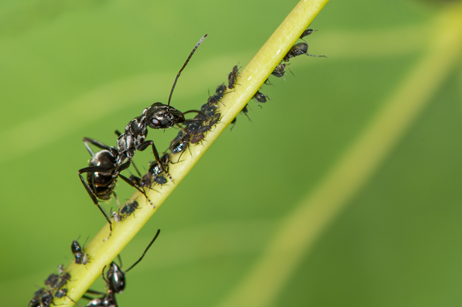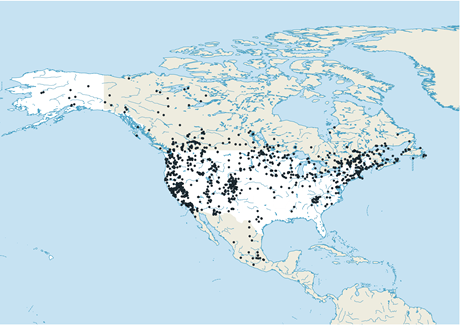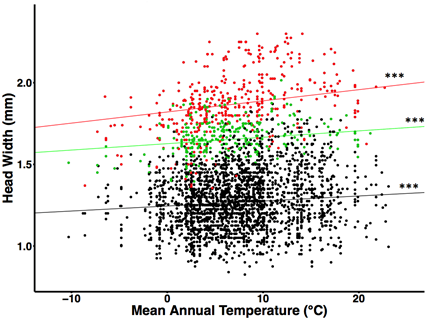by François Brassard
There is no need to
convince curious and nature-loving folks of the worthiness of studying the
remarkable creatures that ants are. But just in case you’re wondering why
anyone in his right mind would make myrmecology (i.e. the study of ants) his
vocation, here are some of my favorite fun facts highlighting the importance
and awesomeness of these insects.
Don’t be fooled by
their diminutive size, ants more than compensate for that with their immense
populations. So much so that in their Pulitzer-prize winning opus “The Ants”, E.O. Wilson (the grand master Jedi of ant science) and his partner in science Bert
Hölldobler, wrote that the total biomass of ants equalled the biomass of
humanity. Considering that an average human weigh about a million times the
average ant illustrates well the sheer number of these insects crawling about on
the planet. They’re also considered
to be ecosystem-engineers in multiple environments, meaning that they can
significantly modify an habitat (this ability ranging from creation to
destruction). For instance, ants are important seed dispersers, they enhance
nutrient cycling and they are considered as dominant herbivores and predators. However,
they also count among their ranks some of the most infamous invasive species,
who can wreak havoc to the communities they invade. At last, let’s not forget
that the Formicidae are also part of one of the most exclusive evolutionary
clubs; the Eusocial taxa.

A Formica worker tending aphids in the Gault nature reserve.
I
could go on for hours on ant trivia, but let’s now focus on their relevance for
research, more specifically biogeography, a science which aims to understand
the distribution of species through space and time. This field of biology has
led to significant discoveries in the past. For instance, patterns of species
distributions were key insights to the elaboration of Darwin’s and Wallace’s
theory of evolution by natural selection and to Wegener’s theory of continental
drift (no big deal). Since ants are widespread and near-ubiquitous on all
continents except Antarctica, it makes them ideal model organisms for biogeography
studies.
Using ants, my
research aims to shed light on what modulates a species size and shape along environmental
gradients. I hope to do so by assessing a dataset of more than 3000 naturalised
specimens of queens, males and workers. Luckily, the utterly massive work of
measuring a dozen minute body parts as well as counting the hairs of all those
pinned insects (a task to make even a monastic scribe squeamish) was
accomplished by the taxonomist Dr Francoeur. Initially, this was part of his
revision of the North American representatives of the Formica genus. However, with this dataset plus the aid of a set of
global climate layers and statistics I can now investigate how environmental
factors modulate morphology.

Distribution of the specimen within the
Francoeur’s dataset used for my analyses.
Thus far, my
preliminary analyses have focused on traits routinely used as proxies for body
size. I started out in this fashion to assess if ants followed one of the most
famous ecological pattern: Bergmann’s rule. This “rule” was initially evoked by
its namesake a while ago (like some 150-plus years ago). It stated that endotherms,
meaning warm-bodied animals, should increase in size at increasing latitudes
because of the surface-to-volume ratio; since volume increases faster than
surface area, large animals lose relatively less heat than their smaller
counterparts. This is all good and well but why would that be something
applicable to ectotherms such as arthropods? Turns out Bergmann’s rule is not
quite the popular trend in insects that it is in mammals and birds. In fact, an
almost equal number of studies found that insects follow the opposite of the
rule; namely that they get smaller with increasing latitudes. Two main
hypotheses have been put forward to explain this. Taxa following the converse
to Bergmann’s rule would be restricted by the shortening of the growing season
at high latitudes. In contrast, the species following the ‘classic’ pattern
would be a result of a physiological response to temperature, where colder
temperatures increase development time faster than it decreases developmental
rate, thus leading to a larger adult size.
With my project, what
I have found out is that all castes (i.e. workers, males and queens) followed
the converse to Bergmann’s rule; ants’ size was smaller in colder environments. Even
more interesting is that the strength of the relationship was strongest in
queens. That makes a lot of sense, queens being the largest they take
more time to develop. Thus, it should be expected that the shorter growing
season length of colder climates will tax them the most. But why does that
matter? Does it make the sovereign caste cuter? Debatable, but it can have
important implications for the occurrence of an ant species. Picture this,
since fecundity is size-dependent in insects and that the amount of fat-reserves
a queen harbours also relates to its size, smaller queens could have a harder
time surviving winters as well as producing enough workers for the colony’s
needs. In turn, we could predict that under a certain size threshold queens are
just too small to subsist and reproduces without coping mechanisms, therefore
limiting the species distribution. After all, queens are egg-laying-machines
that take care of the reproduction within the colony, so no queen equals no
colony. This example demonstrates the importance of taking into account the biology of all castes when studying ecological questions; if
environmental factors end up affecting one more drastically than the other, you could miss out completely
by looking only at for example, workers (which is traditionally the case!)

Relationship between mean annual temperature
(°C) and head width (mm) in workers (black), males (green) and queens (red).
Asterisks denote statistically significant results.
Wisely explained by
the words of science writer David Quammen, biogeography addresses the questions
“Which species? and Where? It also asks, Why? and, what is sometimes even more crucial,
Why not?”. With the completion of my project
I hope to help better our understanding of this fundamental inquiry… and of
course learn more fun facts about ants!

A Formica worker tending aphids near Val-d’Or.
François Brassard is an entomologist with a fascination for ants. He has an Adventure Guide
Diploma from Thompson Rivers University, a BSc in biology from Université Laval
and is currently doing his MSc in biology at Concordia University.

0 Comments